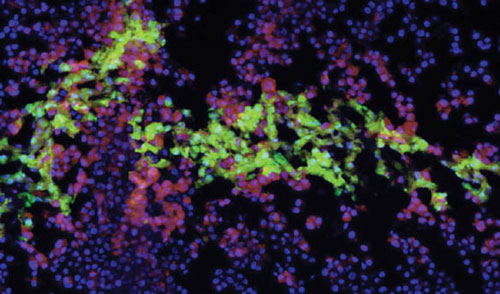| Nov 09, 2013 |
3D-printed liver tissues function normally for 40 days (w/video)
|
|
(Nanowerk News) Organovo Holdings, Inc., a creator and manufacturer of functional, three-dimensional human tissues for medical research and therapeutic applications, provided a summary of the data presented at the 3rd Annual Cell Therapy Bioprocessing Conference in Bethesda, MD International Bioprocessing Conference.
|
 |
| This image is a cross-section of bioprinted human liver tissue demonstrating compartmentalization between the hepatocytes (shown as blue nuclei), endothelial cells (red), and hepatic stellate cells (green).
|
|
Building on data first presented at the Experimental Biology conference in April 2013, the company presented data demonstrating retention of key liver functions in bioprinted tissues for up to 40 days, longer than one month. Additional data presented at the Cell Therapy Bioprocessing Conference demonstrated that Organovo's 3D liver tissues exhibit dose-dependent responses to acetaminophen, a known liver toxicant, and that the toxic effects can be assessed using both standard screening assays and histopathological assessment of the treated tissue. The data demonstrate that Organovo's 3D Liver tissue can potentially have value in assessing toxicology problems in human liver over a long period, including sub-acute and multiple dose effects.
|
|
"This additional functional validation of Organovo's 3D Liver continues the demonstration of strong performance of these tissues," said Keith Murphy, Organovo's chief executive officer. "In April we were able to show that liver function was retained in our 3D Liver for over five days, and we have now demonstrated that our tissues perform consistently for at least 40 days, a significant improvement over the average 48 hour performance of 2D cultures. The stable, liver-specific functionality of 3D Liver is consistent with our observations that other NovoGen bioprinted tissues become fully cellular, steady state, living tissues that persist over time. Furthermore, the fact that these tissues demonstrate similar activity to native liver when presented with a known challenge drug is an encouraging indication of utility in drug development."
|
|
|
|
The bioprinting process.
|
|
The demonstration of extended function in Organovo's 3D liver tissues was achieved faster than Organovo's projected timeline of achieving these results by the end of 2013 and highlights progress in the development of a 3D Human Liver product, which is on track for launch in 2014. The company believes that a multi-cellular bioprinted 3D Liver system with extended life span in culture can provide superior results to current human cellular models and offer significant value to pharmaceutical researchers by enabling assessment of both biochemical and tissue responses.
|

